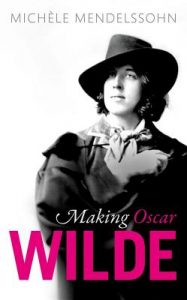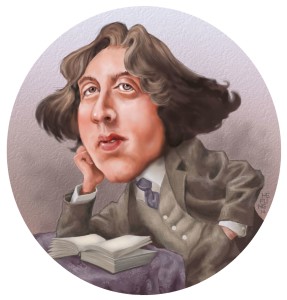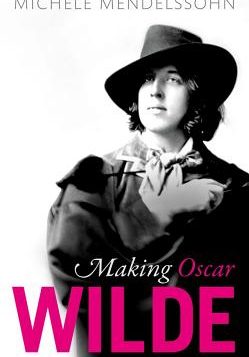 Making Oscar Wilde
Making Oscar Wilde
by Michèle Mendelssohn
Oxford. 360 pages, $24.95
WHEN OSCAR WILDE graduated from Oxford, he had no idea what he wanted to do in life; all he knew was that he wanted to be famous—“and if not famous,” he said, “I’ll be notorious.” Even after winning the Newdigate Prize for poetry at Oxford and taking a First in Greats (the Greek and Roman classics), his application for a fellowship in classics and archaeology was turned down. So he moved to London and tried to make a living as a critic, going to galleries, parties, being amused and amusing. But everyone was still wondering: what does he do? The play he’d written about Russian revolutionaries, Vera, or the Nihilists, was so bad nobody would put it on, so in effect he was unemployed.
Nevertheless, people began to see him as the leader of the Æsthetic Movement—which had actually been created a generation earlier by people like John Ruskin, William Morris Hunt, the pre-Raphaelites, and Walter Pater. None of them, however, wanted to be its leader. But Wilde had attended both Ruskin’s and Pater’s lectures at Oxford. He was, in a way, the bridge between the two—between Ruskin’s belief that art must have moral content and Pater’s espousal of art for art’s sake. A slim volume of poems Wilde published after graduation, more Pater than Ruskin, had been roundly panned for its decadent tone. And when George du Maurier decided to make fun of the Æsthetes with caricatures in Punch, it was Wilde he used as a model. So by the time Gilbert and Sullivan wrote Patience, the operetta that satirized the Æsthetic Movement, Wilde was the inspiration for a character named Bunthorne. And that’s why Oscar Wilde went to the United States in 1882. That was the year the impresario Richard D’Oyly Carte decided that sending Wilde to the U.S. would drum up publicity for the American tour of Patience, and Wilde, having no other source of income or prospect of employment, agreed to go.
Thus begins Michele Mendelssohn’s astonishing demonstration that just when you thought you knew everything about the life of Oscar Wilde, there’s more. Making Oscar Wilde turns out to be not just about Wilde, however; it’s about the U.S. at a time when when P. T. Barnum was drawing them in with exhibits like “The Wild Man of Borneo,” minstrel shows were exceedingly popular, and Darwin’s idea that we are descended from apes was on everyone’s mind. It was a time when people paid money to attend lectures, producers were becoming skilled in the art of publicity, and the press was discovering the power of the interview. It was also a time when a flood of immigrants was so threatening to the Anglo-American majority that “Paddy” (the stereotypically shiftless, drunken, violent Irishman) was considered, along with the poor, illiterate, and formerly enslaved Negro, to be closer to the apes than to themselves.
 Wilde knew he was being used, but he was still not prepared for the reception he got when he landed in New York. The legend that he told the customs agent upon disembarking, “I have nothing to declare but my genius,” may be apocryphal, but no novelist could make up most of what really happened. The train car in which Wilde traveled from Omaha to the Pacific Coast—at 18 miles per hour—was hung with a white sheet on which the name Oscar Wilde was painted in big black letters to let people know that he was about to appear at the next stop. Sometimes Wilde would get off to stretch his legs during stops, and sometimes the actor playing Bunthorne would stroll the platform, making fun of Wilde. At that point, Patience, and the numerous minstrel shows satirizing Wilde, were pulling in much bigger crowds than Wilde himself. At times Wilde’s box office was not enough to cover the wine tab he ran up to calm his nerves after giving a lecture.
Wilde knew he was being used, but he was still not prepared for the reception he got when he landed in New York. The legend that he told the customs agent upon disembarking, “I have nothing to declare but my genius,” may be apocryphal, but no novelist could make up most of what really happened. The train car in which Wilde traveled from Omaha to the Pacific Coast—at 18 miles per hour—was hung with a white sheet on which the name Oscar Wilde was painted in big black letters to let people know that he was about to appear at the next stop. Sometimes Wilde would get off to stretch his legs during stops, and sometimes the actor playing Bunthorne would stroll the platform, making fun of Wilde. At that point, Patience, and the numerous minstrel shows satirizing Wilde, were pulling in much bigger crowds than Wilde himself. At times Wilde’s box office was not enough to cover the wine tab he ran up to calm his nerves after giving a lecture.
The problem was that Wilde’s lecture was stiff and academic—the talk you might expect from a brilliant Oxford graduate. It took him some time to discover that the aphorisms he spontaneously spouted during interviews with the press were far more entertaining than anything in his formal lecture, so halfway through his tour he dumped the academic matter and began giving lectures called “The House Beautiful” and “The Decorative Arts.” The irony is that the man the papers were sending up as a fraudulent fop was totally sincere: he believed that art could make everyone’s life better. But the people to whom he was delivering his lecture wanted a freak show. At Harvard, he was mocked by fifty or so undergraduates who came dressed as Bunthorne, carrying sunflowers—the symbol of the Æsthetic Movement—and striking poses. Wilde held his ground that night and was applauded for it. But then the same thing happened at Yale and at the University of Rochester, only in these cases the man leading the parade of Bunthorne was black.
The curious process by which Oscar Wilde turned out to be African (in both minstrel shows and popular illustrations) is traced in 48 glossy plates that reproduce prints, caricatures, and commercial advertisements inspired by Wilde’s visit. The first one is a Currier & Ives print called The Aesthetic Crazethat turns Wilde into a scrawny young black man in knee-breeches carrying a large sunflower while two African-American women look at him amorously above the caption: “What’s de mattah wid de Nigga? Why Oscar you’s gone wild!” The Washington Postpublished a full-page illustration bearing two images—one, a simian-looking Wild Man of Borneo, the other, Oscar holding a sunflower—and the question: “How far is it from this to this?” The Postconsidered Wilde one of the “great social evils.” and predicted, with astonishing vitriol, that “All true Englishmen will be glad if we can terrify him back to Britain, so that they may kill him.”
What Wilde, the Wild Man of Borneo, and the American Negro apparently had in common was that all three were considered primitive throwbacks by a culture fascinated by Darwin and the notion that human beings are descended from apes. Barnum had an exhibit called What Is It?in which a man of indeterminate race challenged onlookers to place him on the evolutionary spectrum. The same question was asked of Wilde. And when not being portrayed as either a Negro or an aboriginal, Wilde was attacked for being a fake Englishman. True, he’d gone to Oxford and spoke with a posh accent and was Protestant—but, a visiting British editor huffed, he was Irish. And one thing was clear: there was nothing lower in the eyes of Anglos on both sides of the Atlantic than that.
Oscar was constantly learning, however, and by the time he got to San Francisco, he was playing the Irish card. In the eastern cities the Irish might be living in slums; but in San Francisco they were rich, prominent, and thrilled by Wilde’s support for Irish independence from England. He was shrewd enough as well to combine criticism of America with compliments. He made a point to praise American women, and told reporters south of the Mason-Dixon line that Southerners had far better manners than their northern counterparts. In New Orleans Wilde even found an uncle who had immigrated to Louisiana and become a wealthy slave-holder—a pillar of New Orleans society. And, to complicate things, Wilde not only identified with the Southern aristocracy but said the person he most wanted to meet, and took a train to see, was Jefferson Davis. Davis did not care about Wilde, though Walt Whitman responded so warmly to Oscar’s admiration the day Wilde visited that years later Oscar told a friend: “The kiss of Walt Whitman is still on my lips.”
What the press was most interested in, however, was what Wilde thought of the United States. Like Frances Trollope and Charles Dickens before him, Oscar was asked to rate the colonials. He did not mince words. He accused the press of making up what it wanted to, claimed American men were philistine workaholics who left all cultural matters to their wives, and said that nobody in England would have been treated as he had been on his tour of the States. And the more he did this, the more he found his voice—critical, sharp, aphoristic, amusing. Before giving an interview, Wilde’s black valet would lay his cloak out on a divan; and then Oscar would enter in knee breeches and velvet coat and arrange himself in a languorous position, looking for all the world like Sarah Bernhardt (or Lili von Shtupp in Blazing Saddles). All of this, Mendelssohn says, was laying the groundwork for his career in the theater. It was his tour of America that confirmed Wilde in his belief that everyone is playing a part, that we are all posing, and that only when masked do we reveal our true selves.
One of the most popular features of the minstrel show, for instance, came at the halfway point, when a man called the Interlocutor would sit down center stage with two men in blackface (most likely Irish-American actors) on his left and right—Tambo and Bones—and ask the faux-Negroes questions that provided a feast of one-liners, jokes, and overall demonstration of wit. According to Mendelssohn, Wilde used this moment in the plays he wrote when he returned to England. It’s a not unpersuasive argument. So much of Wilde’s writing consists of colloquies in which a “straight man” (or woman) sets up the character (e.g., Lady Bracknell), who produces the witty aphorism. Wilde, Mendelssohn suggests, took the blackface tradition of the Interlocutor and turned it on the hypocrisies of Victorian society. It was the Christy Minstrels that critics recognized in the hit plays he wrote when he got home—plays that revived an English theater that had been essentially moribund, said one critic, since the days of Richard Brinsley Sheridan.
The questions reporters asked when Wilde arrived in New York ran the gamut from “What are aesthetics?” to “Do you like eggs fried on both sides or only on one side?” and “Do you trim your finger-nails in the style of the Empress of Japan?” In The Importance of Being Earnest, when Lady Bracknell interviews Jack Worthing as a prospective son-in-law, she investigates more practical matters: “What are your politics?,” “What is your income?,” and “Are your parents living?” But Jack’s answers are only a setup for Lady Bracknell’s immortal put-downs. The tragedy of Oscar Wilde is multifaceted but one of the most tantalizing losses is not knowing what he might have written after making the quantum leap from the conventional drawing room drama of A Woman of No Importanceand An Ideal Husbandto the sublime nonsense of Lady Bracknell’s riposte: “To lose one parent, Mr. Worthing, may be regarded as a misfortune; to lose both looks like carelessness.”
But as we know, there was another tragedy. After Wilde returned from the USA, more famous than he’d ever been before, with money in his pocket, a firm grasp of publicity, and a voice in which to write, he edited a women’s magazine and toured England with a lecture called Impressions of Americaand then wrote Lady Windemere’s Fan. Hit followed hit. Henry James, who called on Wilde at his hotel when they were both in Washington (since James’ hostess Clover Adams refused to have Wilde in her house), considered Wilde “a fatuous cad, an unclean beast.” But Wilde had a kind of success that eluded James. In another of those moments that one could not make up, James was in the audience of An Ideal Husbandthe night his own play, Guy Domville, was premiering nearby; and when James went down the street and took the call for “Author! Author!” he was booed off stage. And the play that replaced James’ flop was The Importance of Being Earnest.
But then came Lord Alfred Douglas, the Marquis of Queensbury, the trial, and a downfall that even James called “hideously tragic.” At one point in Making Oscar Wilde, our hero is left standing on the train platform at Clapham Junction in prison garb and chains, being laughed at by the very public that had made him famous. No wonder the story of Oscar has been dramatized so many times. Stephen Fry opened his 1997 movie Wilde with a scene from the American tour: Oscar descending into the mine in Leadville, Colorado, entrancing the muscular miners with a lecture on Cellini. But there’s so much more in Mendelssohn’s account of his trip to America. It’s odd to say this of a book from Oxford University Press, but someone could make a movie out of Making Oscar Wilde.
Reading the book, however, one finds oneself still wondering: Just what was it about Wilde that was so threatening to people? One might start with the disorienting combination of Wilde’s six-foot-four, massive frame and that soft, Pre-Raphaelite face. There was, one learns in Mendelssohn, an element of sexual jealousy in all of this: the Æsthetic dandy was thought to be more appealing to women than the masculine man. Then there was Wilde’s telling people how they should live, and his audience’s resistance to the gospel of art. About the latter, of course, Wilde was right: the U.S. is still a country that will spend billions on a new bomber but refuse to support a ballet dancer or even its national parks. And American men are still, as Wilde observed, workaholics who care mostly about business and leave culture to the women. And the arts, when not entertainment, are still suspect. Whether it was his androgyny, his sensuality, his snobbery, or his espousal of the gospel of art, it is hard to know; but something led people to find Wilde extremely threatening.
Mendelssohn concludes with a predictable claim that 1882 “was a time that resembles our own in many ways,” when the U.S. “grappled with massive waves of immigration, nationalist movements, racial and ethnic conflicts, political upheavals, new media technologies, and a sensation-hungry press.” But in this case the pro forma observation seems quite valid. The racial stew in the U.S. continues to bubble. Hence it’s not surprising that Mendelssohn has essentially used Oscar Wilde to write a book about racial and ethnic tensions. But the irony is that what the playwright learned on his American tour had little to do with race. Wilde, who was in many ways a tremendous snob, neither sympathized as an Anglo-Irishman with American Negroes, nor seemed to be interested in the subject of racial categories at all. His mind, his gift, his ambitions, lay further afield.
Andrew Holleran’s fiction includes Dancer from the Dance, Grief, and The Beauty of Men.






